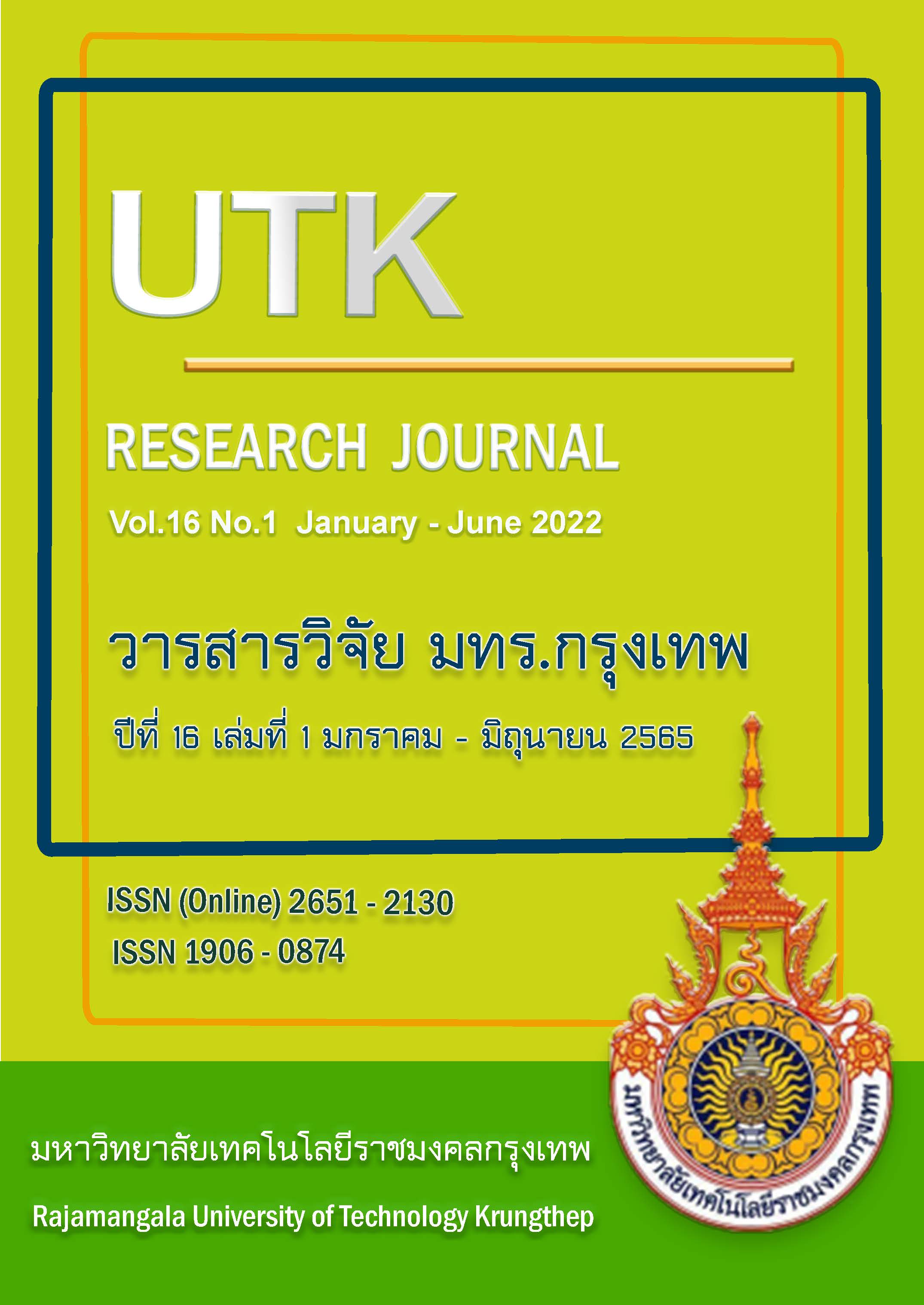การพัฒนาระบบสืบค้นที่มาของลายผ้าย้อมครามด้วยเทคนิคการเรียนรู้เชิงลึก
คำสำคัญ:
การเรียนรู้เชิงลึก, การประมวลผลภาพ, ลายผ้าคราม, โครงข่ายประเทียมแบบสังวัตนาการบทคัดย่อ
งานวิจัยนี้เป็นการประยุกต์ใช้เทคโนโลยีการประมวลผลภาพด้วยเทคนิคการเรียนรู้เชิงลึกเพื่อจำแนกลายผ้าย้อมครามของกลุ่มแปรรูปผ้าย้อมครามธรรมชาติที่ได้ขึ้นทะเบียนขอใช้ตราสัญลักษณ์สิ่งบ่งชี้ทางภูมิศาสตร์ (Geographical indication: GI) ในจังหวัดสกลนคร จำนวน 42 กลุ่ม โดยเก็บรวบรวมข้อมูลภาพถ่ายลายผ้าครามทั้งหมด 216 ลาย และได้ประยุกต์ใช้สถาปัตยกรรมของโครงข่ายประสาทเทียมแบบสังวัตนาการ (CNN) ด้วยโมเดล ResNet50 สำหรับสร้างแบบจำลอง ผลการวิจัย พบว่าความแม่นยำของแบบจำลองโดยรวมมีค่าสูงสุดที่ 93% และมีค่าความผิดพลาดลดลงที่ 0.09% จากนั้นนำแบบจำลองมาพัฒนาระบบสืบค้นที่มาของลายผ้าครามด้วยเทคนิคการเรียนรู้เชิงลึก โดยผลการประเมินความแม่นยำของระบบจากตัวอย่างลายผ้าครามจำนวน 10 ลาย พบว่ามีความแม่นยำ 80% ขึ้นไป ซึ่งงานวิจัยนี้นอกจากจะทำให้ทราบถึงอัตลักษณ์ที่มาและข้อมูลพื้นฐานของลายผ้าคราม และยังเป็นส่วนหนึ่งในการประชาสัมพันธ์การท่องเที่ยวชุมชน “วิถีคราม” ส่งผลให้ชุมชนเกิดรายได้เพิ่มขึ้น มีความมั่นคง ยั่งยืนต่อไป
เอกสารอ้างอิง
อนุรัตน์ สายทอง, อังคณา เทียนกลุ่ม, สุดกลม ลาโสภา. ครามและผลิตภัณฑ์คราม. สกลนคร: มหาวิทยาลัยราชภัฏสกลนคร; 2554.
กระทรวงวิทยาศาสตร์และเทคโนโลยี ร่วมกับมหาวิทยาลัยเทคโนโลยีราชมงคลอีสาน วิทยาเขตสกลนคร. การพัฒนาผลิตภัณฑ์ผ้าสกลนคร; 2555.
สำนักงานเกษตรจังหวัดสกลนคร กรมส่งเสริมการเกษตร กระทรวงเกษตรและสหกรณ์. แผนพัฒนาการเกษตรจังหวัดสกลนครปี 2563-2564; 2562.
นพรุจ พัฒนาสาร, ณัฐวุฒิ ศรีวิบูลย์. การประมวลผลภาพสำหรับจำแนกคุณภาพมะม่วงพันธ์โชคอนันต์ โดยการจำลองการมองเห็นของมนุษย์ด้วยวิธีการเรียนรู้เชิงลึก. Journal of Information Science and Technology. 2563;10(1):24-29.
Shamrat FJM, Mahmud I, Rahman AS, et al. A smart automated system model for vehicles detection to maintain traffic by image processing. International Journal of Scientific & Technology Research. 2020; 9(02):2921-2928.
Rahouma KH, Mahfouz AZ. Design and implementation of a face recognition system based on API mobile vision and normalized features of still images. Journal of Procedia Computer Science. 2021;194:32-44.
Rahmatov N, Paul A, Saeed F, et al. Machine learning–based automated image processing for quality management in industrial Internet of Things. International Journal of Distributed Sensor Networks. 2019;15(10):1-11.
Schlett T, Rathgeb C, Busch C. Deep learning-based single image face depth data enhancement. Computer Vision and Image Understanding Journal. 2021;210:1-15.
Gjoreski M, Gradišek A, Budna B, et al. Machine learning and end-to-end deep learning for the detection of chronic heart failure from heart sounds. IEEE Access. 2020;8:20313-20324.
Han C, Lei S, Mingming W, et al. Innovative design of traditional calligraphy costume patterns based on deep learning. In Journal of Physics: Conference Series. 2021;1790(1):1-6.
LeCun Y, Bottou L, Bengio Y, et al. Gradient based learning applied to document recognition. In: Proceedings of the IEEE. 1998;86(11):2278–2324.
Wang D, Wang J, Li W, et al. T-CNN: Trilinear convolutional neural networks model for visual detection of plant diseases. Computers and Electronics in Agriculture Expert Systems with Applications Journal. 2021;190:1-10.
Giuseppe CA. ResNet-50-based Convolutional neural network model for language ID identification from speech recordings. Proceedings of the Third Workshop on Computational Typology and Multilingual NLP; 2021 June. Association for Computational Linguistics. 2021:136-144.
Zhang H, Jiang L, Li C. Cs-resnet: cost-sensitive residual convolutional neural network for PCB cosmetic defect detection. Expert Systems with Applications Journal. 2021;185:1-10.
Yamane T. Statistics: An introduction analysis. New York: Harper & Row; 1973.
Bruckhaus T. The business impact of predictive analytics. In Knowledge discovery and data mining: Challenges and realities. USA: Igi Global; 2007.
ดาวน์โหลด
เผยแพร่แล้ว
รูปแบบการอ้างอิง
ฉบับ
ประเภทบทความ
สัญญาอนุญาต
ลิขสิทธิ์ (c) 2022 วารสารวิจัย มทร. กรุงเทพ

อนุญาตภายใต้เงื่อนไข Creative Commons Attribution-NonCommercial-NoDerivatives 4.0 International License.
กองบรรณาธิการวารสารวิชาการ มหาวิทยาลัยเทคโนโลยีราชมงคลกรุงเทพ มีความยินดีที่จะรับบทความจากอาจารย์ นักวิจัย นักวิชาการทั้งภายในและภายนอกมหาวิทยาลัย ในสาขาวิชาวิทยาศาสตร์และเทคโนโลยี ได้แก่ สาขาวิชาวิทยาศาสตร์ วิศวกรรมศาสตร์ และสาขาอื่นๆ ที่เกี่ยวข้อง รวมถึงสาขาต่างๆ ที่มีการบูรณาการข้ามศาสตร์ที่เกี่ยวข้องวิทยาศาสตร์และเทคโนโลยี ที่เขียนเป็นภาษาไทยหรือภาษาอังกฤษ ซึ่งผลงานวิชาการที่ส่งมาขอตีพิมพ์ต้องไม่เคยเผยแพร่ในสิ่งพิมพ์อื่นใดมาก่อน และต้องไม่อยู่ในระหว่างการพิจารณาของวารสารอื่น
การละเมิดลิขสิทธิ์ถือเป็นความรับผิดชอบของผู้ส่งบทความโดยตรง บทความที่ได้รับการตีพิมพ์ต้องผ่านการพิจารณากลั่นกรองคุณภาพจากผู้ทรงคุณวุฒิและได้รับความเห็นชอบจากกองบรรณาธิการ
ข้อความที่ปรากฏอยู่ในแต่ละบทความที่ตีพิมพ์ในวารสารวิชาการเล่มนี้ เป็นความคิดเห็นส่วนตัวของผู้เขียนแต่ละท่าน ไม่เกี่ยวข้องกับมหาวิทยาลัยเทคโนโลยีราชมงคลกรุงเทพแต่อย่างใด ความรับผิดชอบด้านเนื้อหาและการตรวจร่างบทความแต่ละบทความเป็นของผู้เขียนแต่ละท่าน หากมีความผิดพลาดใดๆ ผู้เขียนแต่ละท่านจะต้องรับผิดชอบบทความของตนเองแต่ผู้เดียว
กองบรรณาธิการขอสงวนสิทธิ์มิให้นำเนื้อหา หรือข้อคิดเห็นใดๆ ของบทความในวารสารวิชาการ มหาวิทยาลัยเทคโนโลยีราชมงคลกรุงเทพ ไปเผยแพร่ก่อนได้รับอนุญาตจากกองบรรณาธิการ อย่างเป็นลายลักษณ์อักษร ผลงานที่ได้รับการตีพิมพ์ถือเป็นลิขสิทธิ์ของวารสาร






